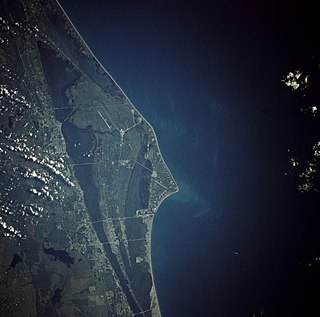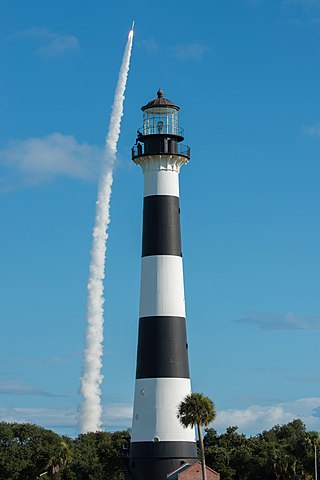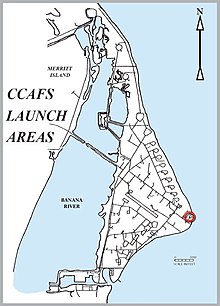
The John F. Kennedy Space Center, located on Merritt Island, Florida, is one of the National Aeronautics and Space Administration's (NASA) ten field centers. Since December 1968, KSC has been NASA's primary launch center of American spaceflight, research, and technology. Launch operations for the Apollo, Skylab and Space Shuttle programs were carried out from Kennedy Space Center Launch Complex 39 and managed by KSC. Located on the east coast of Florida, KSC is adjacent to Cape Canaveral Space Force Station (CCSFS). The management of the two entities work very closely together, share resources, and operate facilities on each other's property.

Cape Canaveral is a cape in Brevard County, Florida, in the United States, near the center of the state's Atlantic coast. Officially Cape Kennedy from 1963 to 1973, it lies east of Merritt Island, separated from it by the Banana River. It is part of a region known as the Space Coast, and is the site of the Cape Canaveral Space Force Station. Since many U.S. spacecraft have been launched from both the station and the Kennedy Space Center on adjacent Merritt Island, the two are sometimes conflated with each other.

Cape Canaveral Space Force Station (CCSFS) is an installation of the United States Space Force's Space Launch Delta 45, located on Cape Canaveral in Brevard County, Florida.

The Cape Canaveral Light is a historic lighthouse on the east coast of the U.S. state of Florida. The light was established in 1848 to warn ships of the dangerous shoals that lie off its coast. It is located inside the Cape Canaveral Space Force Station and managed by the Space Launch Delta 45 of the U.S. Space Force with the assistance of the Cape Canaveral Lighthouse Foundation. It is the only fully operational lighthouse owned by the United States Space Force.

Launch Complex 34 (LC-34) is a deactivated launch site on Cape Canaveral Space Force Station, Florida. LC-34 and its companion LC-37 to the north were used by NASA from 1961 through 1968 to launch Saturn I and IB rockets as part of the Apollo program. It was the site of the Apollo 1 fire, which claimed the lives of astronauts Gus Grissom, Ed White, and Roger Chaffee on January 27, 1967. The first crewed Apollo launch — Apollo 7 on October 11, 1968 — was the last time LC-34 was used.

Space Launch Complex 41 (SLC-41), previously Launch Complex 41 (LC-41), is an active launch site at Cape Canaveral Space Force Station. As of 2024, the site is used by United Launch Alliance (ULA) for Atlas V and Vulcan Centaur launches. Previously, it had been used by the United States Air Force for Titan IIIC, Titan IIIE, and Titan IV launches.

Launch Complex 14 (LC-14) is a launch site at Cape Canaveral Space Force Station in Florida. LC-14 was used for various crewed and uncrewed Atlas launches, including the Friendship 7 flight aboard which John Glenn became the first American to orbit the Earth in February 1962.

Cape Canaveral Launch Complex 5 (LC-5) was a launch site at Cape Canaveral Space Force Station, Florida used for various Redstone and Jupiter launches.

Launch Complex 36 (LC-36)—formerly known as Space Launch Complex 36 (SLC-36) from 1997 to 2010—is a launch complex at Cape Canaveral Space Force Station in Brevard County, Florida. It was used for Atlas launches by NASA and the U.S. Air Force from 1962 until 2005.

Space Launch Complex 40 (SLC-40), sometimes referred to as "Slick Forty," is a launch pad located at Cape Canaveral Space Force Station in Florida. Initially opened as Launch Complex 40 (LC-40) and used by the United States Air Force for 55 launches of rockets from the Titan family between 1965 and 2005. In 2007, SpaceX acquired a lease for SLC-40 and has since transformed the complex into a high-volume launch site for the Falcon 9 rocket. As of August 2024, the pad has hosted over 200 Falcon 9 launches.

The Space Launch Delta 45 is a unit of the United States Space Force. The Space Launch Delta 45 is assigned to Space Systems Command and headquartered at Patrick Space Force Base, Florida. The wing also controls Cape Canaveral Space Force Station. The 45th Space Delta is responsible for all space launch operations from the East Coast. It manages the Eastern Range, including launch activities for the Space Force, Department of Defense (DoD), NASA, and other private space corporations.

The United States Space Force's 5th Space Launch Squadron is a space launch unit located at Patrick Space Force Base, Florida. The 5th SLS is tasked with launch and support of the National Security Space Launch, Evolved Expendable Launch Vehicles.

The Cape Canaveral Space Force Museum is located at Launch Complex 26 at Cape Canaveral Space Force Station, Florida. It includes artifacts from the early American space program and includes an outdoor area displaying rockets, missiles, and space-related equipment chronicling the space and missile history of the US Air Force, the US Space Force and other military branches.
Launch Complex 6 (LC-6) at Cape Canaveral Space Force Station, Florida is a launch site used by Redstone and Jupiter series rockets and missiles. It is on the south end of Cape Canaveral, close to Launch Complex 5, with which it shared a blockhouse. With LC-5, it was the location of the first tests of the mobile launch concept designed by Kurt H. Debus. This concept was revised and improved and eventually used at LC-39 for the Saturn V and Space Shuttle.

Launch Complex 13 (LC-13) was a launch complex at Cape Canaveral Space Force Station (CCAS), the third-most southerly of the original launch complexes known as Missile Row, lying between LC-12 and LC-14. In 2015, the LC-13 site was leased by SpaceX and was renovated for use as Landing Zone 1 and Landing Zone 2, the company's East Coast landing location for returning Falcon 9 and Falcon Heavy launch vehicle booster stages. It is leased by US Space Force to Phantom Space and Vaya Space who will operate this launch complex after the termination of SpaceX's lease in future.

The Space Launch Complex 46 (SLC-46), previously Launch Complex 46 (LC-46), is a launch complex at Cape Canaveral Space Force Station operated under license by Space Florida previously used for Athena rocket launches. It has been used by Astra, which will continue the use with Rocket 4 and maybe 5 and will be used by ABL Space Systems for the near-term use by RS1.

The Mercury Control Center provided control and coordination of all activities associated with the NASA's Project Mercury flight operation as well as the first three Project Gemini flights. It was located on the Cape Canaveral Space Force Station, east of Samuel C. Phillips Parkway.

Landing Zone 1 and Landing Zone 2, also known as LZ-1 and LZ-2 respectively, are landing facilities at Cape Canaveral Space Force Station used by SpaceX. They allow the company to land the first stage of its Falcon 9 rocket or the two side boosters of its Falcon Heavy rocket.

Telstar 18V(Telstar 18 Vantage / APStar 5C) is a communication satellite in the Telstar series of the Canadian satellite communications company Telesat. T18V will be equipped with C and Ku-band transponders and operate from 138° East. At 7,060 kilograms (15,560 lb), it is the second-heaviest communication satellite ever launched, weighing slightly less than its sibling Telstar 19V.



















